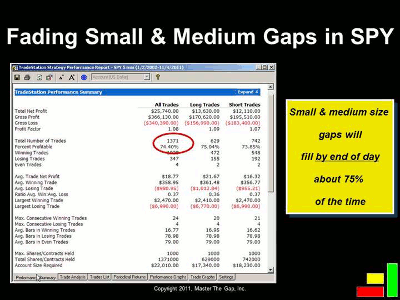Gaps are forming perhaps more frequently now than ever before, says Scott Andrews, but not every gap is a tradable one. Here's how to identify gap set-ups that work almost 75% of the time.
Talking gaps with the gap guy, Scott Andrews. Scott, all this volatility has to have given us lots of gaps; small ones, big ones, in-between ones…does size matter with gaps?
It does, and you’re absolutely correct. We’re having more (and larger) gaps now than probably in any period other than maybe 2008 that I’ve traded gaps. So size does matter.
A lot of folks stay away from the large gaps because they’re too scary. Other folks can’t stand the small gaps because the payoff is not big enough.
I brought along a little bit of research I’m going to share and sort of talk through the way I interpret historical data as it relates to the size of the gap and the way to trade the gaps as a result.
This slide shows that since 2002, there have been almost 1400 of what I call “small and medium-sized” gaps.
How do you define “small?”
There’s a lot of ways to do it, but I defined it based upon the five-day average true range (ATR). This is a little bit intense, but ATR is a fairly well-known concept.
Five-day average true range is a volatility measure. If the gap is less than 40% of the five-day ATR—it’s just my benchmark; I draw a line 40% of the five-day average true range—it’s more than likely going to be what people often refer to as a “common gap.”
Common gaps, to me, are great, because I fade the gap. If the gap is up, I short it. If the gap is down, I buy it (if it meets my criteria, which are all historically based).
So, what the slide shows is that the smaller gaps happen frequently. Almost 1400 of them since 2002, and over 74% have filled by the end of the day they were created, which means they retraced back to the prior day’s closing price.
That’s simply my definition. Where we open versus where we close is the gap, and 74% of the time, they fill.
NEXT: How to Manage Risk If (or When) You're Wrong
|pagebreak|Excellent for a daytrader.
Yeah, it’s good. It’s probably the only time of the day there’s an actual bias that you can trade around.
Now you can’t trade all the gaps; you won’t make any money doing it. You can be selective, but it’s nice to know that the wind is at your back more times than not when you’re trading these small and mid-sized gaps.
How do you protect yourself in the small event that you’re wrong?
Well, I’m wrong frequently. In fact, I’m wrong about one time out of three. So, two times out of three, I’m right. One time out of three, I’m wrong, but I make enough money when I’m right to more than compensate for my losses.
I use a stop, a fixed stop. When I set up my order, I target the gap fill level or beyond, and I use a stop that’s based upon the current volatility, the current five-day average true range. Generally, I use about 30% of the five-day average true range.
So, in real terms for people who may not be familiar with the term, that’s about $0.80 in the Spyder Trust (SPY) with the current volatility. Sometimes it’s as small as $0.50 or $0.60, up to $1.00, in SPY.
As the volatility increases, do you reduce your position size?
Absolutely, because as the volatility increases, 30% of that volatility—my stop—increases. If I’m using a bigger stop, I’m risking more.
I trade the E-mini S&P 500, and I’m risking more per contract. If I’m risking more per contract, I have to trade fewer contracts because you never want to exceed your maximum dollar loss amount on a given day.
How long do you give this trade to work?
Well, I’m always done that day. If I’m trading futures, I don’t take any overnight risk, and quite frankly, if a gap doesn’t fill that day, there’s only a 25% chance of it filling the subsequent day, so no sense holding on to it. It’s probably going to hurt you even more the next day.
I always close out at the end of the day in the rare event—and it is fairly rare—that my stop is not hit or the gap is not filled.
Related Reading:




















